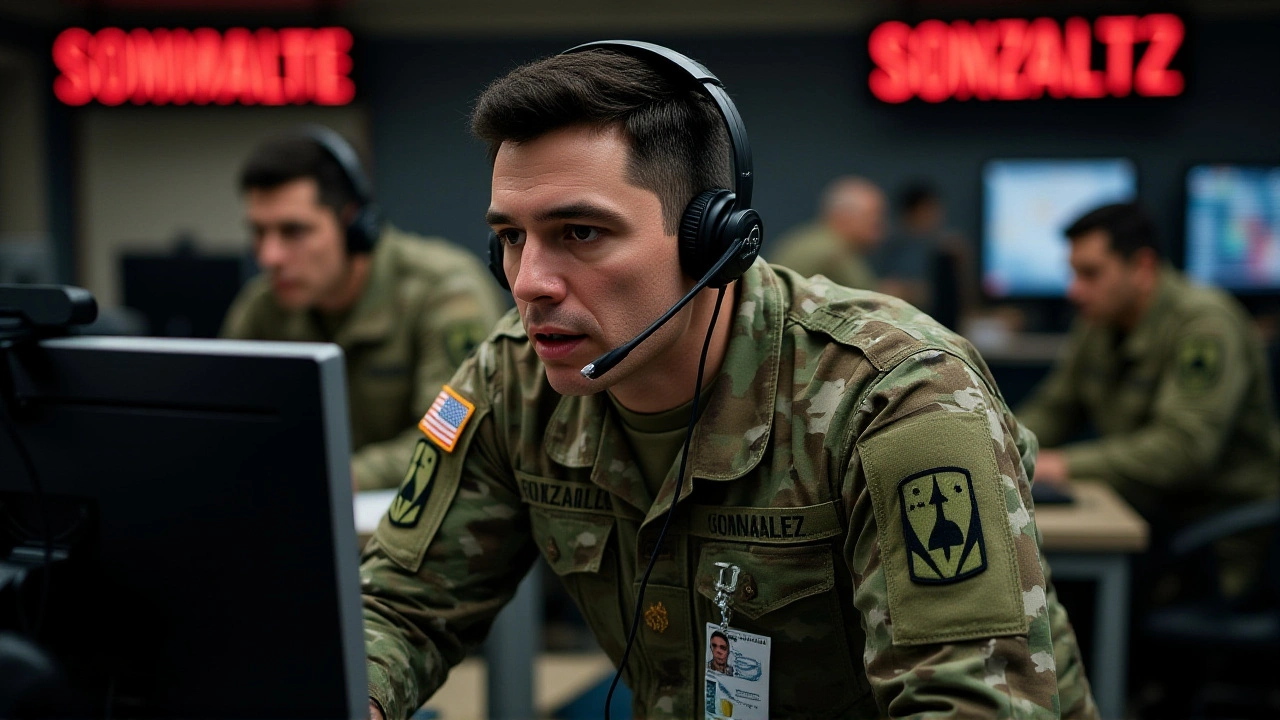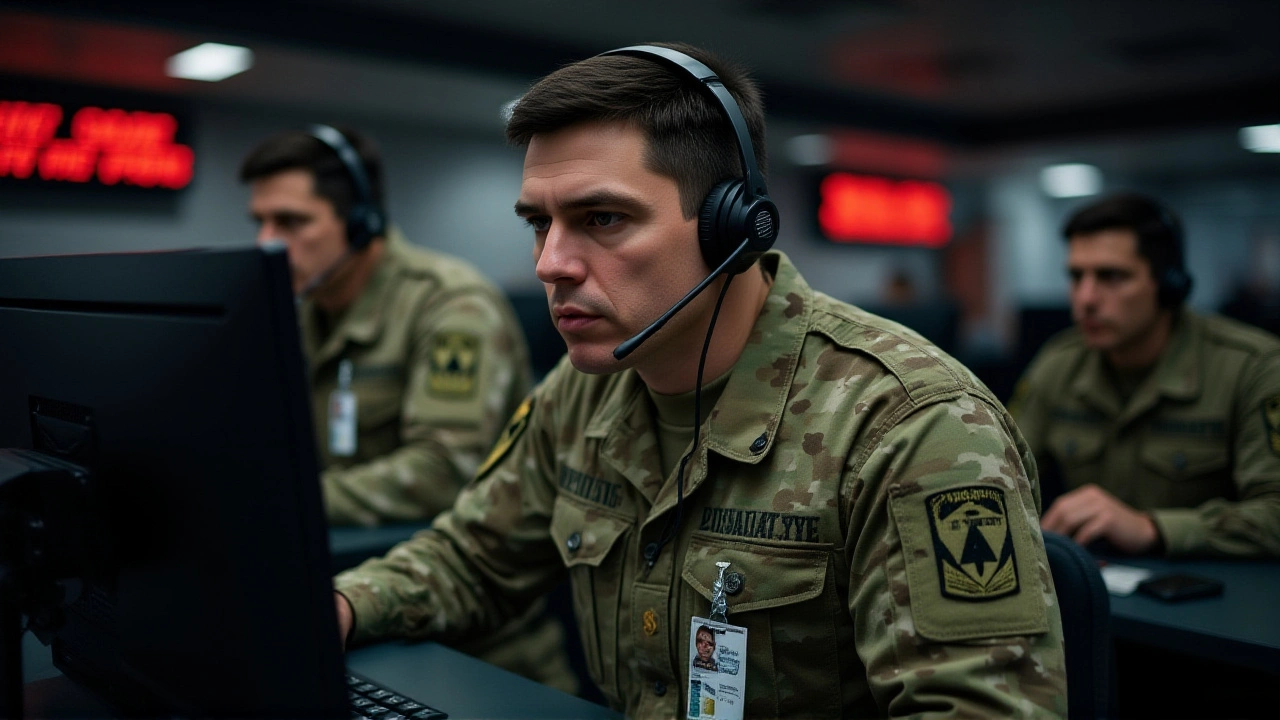Idris Elba Leads Nuclear Thriller ‘A House of Dynamite’ After Venice Premiere
 Oct, 26 2025
Oct, 26 2025
When Kathryn Bigelow, the two‑time Oscar‑winning director of The Hurt Locker and Zero Dark Thirty, teamed up with former NBC news executive Noah Oppenheim to pen a high‑stakes political thriller, the result was A House of Dynamite, a film that puts an entire nation on edge in under two hours.
The story rolls out the moment an unidentified intercontinental ballistic missile (ICBM) is detected barreling toward Chicago. The President, played by Idris Elba, is yanked from a basketball game in Washington D.C. and thrust into a frantic, split‑second decision‑making process. Beside him is Lieutenant Commander Robert Reeves, portrayed by Jonah Hauer‑King, who serves as the president’s tactical adviser.
The film debuted in competition at the 82nd Venice International Film FestivalVenice, Italy on September 2, 2025, where it earned a coveted Golden Lion nomination. A week later, the UK got a limited theatrical run on October 3, followed by a U.S. opening on October 10. Two weeks after the American premiere, the movie settled onto the stream‑heavy home of Netflix for a global debut on October 24.
Background: Bigelow’s Return to the War‑Zone Thriller
Bigelow hadn’t tackled a pure political thriller since Zero Dark Thirty. The director’s interest in the mechanics of war and the human toll of conflict made the premise of a single, untethered nuclear strike a perfect canvas. Oppenheim, whose résumé includes the thriller‑heavy TV series Jack Ryan, brought a journalistic eye to the script, consulting former Pentagon officials to make the crisis protocols feel authentic.
Plot Mechanics and Key Sequences
The narrative hinges on three interlocking arcs. First, the President’s hurried evacuation via Marine One, a scene that builds tension by cutting between the cockpit and a frantic scramble at the White House communications hub. Second, Secretary of Defense Reid Baker—played with stoic intensity by Jared Harris—realizes his daughter Caroline (Kaitlyn Dever) is trapped in the impact zone and, after a failed rescue attempt, takes his own life on the Pentagon roof. The third arc follows Major Daniel Gonzalez (Anthony Ramos) at Fort Greely, Alaska, who watches the mushroom cloud bloom from a cold, early‑morning watch.
One of the film’s most talked‑about moments is the “rewind” sequence that flashes back to the basketball arena, showing Reeves laying out two retaliation options before the President must decide alone. The choice isn’t presented as a moral dilemma so much as a cold, procedural calculus—an homage to the director’s earlier work on the bureaucracy of war.
Responses from Cast, Critics, and Audiences
After the Venice screening, Elba praised the script’s “unflinching look at what leadership looks like when the world is about to end.” Jared Harris noted that “the suicide scene was filmed with the counsel of a military psychologist to avoid glorifying tragedy.” Critics have been split: some hail the film as “a masterclass in tension” (The Guardian), while others argue the pacing drags in the mid‑section when the plot shifts to the Raven Rock Mountain Complex in Pennsylvania.
Box‑office numbers from the U.K. opening weekend show a modest £1.2 million intake, suggesting the film leans more on prestige than blockbuster draw. Netflix reports that within its first week of streaming, the title ranked in the top three most‑watched movies in 27 territories, indicating a strong pull for viewers seeking serious, adult‑oriented thrillers.

Impact on the Industry and Distribution Strategy
Bigelow’s partnership with Netflix marks a shift in how high‑budget, award‑season films can be rolled out. The 17‑day theatrical window between the U.K. and U.S. releases, followed by a 14‑day exclusive streaming period, reflects an emerging model that balances traditional cinema prestige with the immediacy of streaming audiences.
Industry analysts note that the film’s Golden Lion nomination gives Netflix an “Oscar‑ready” film for the upcoming awards season, potentially encouraging other studios to explore similar hybrid release patterns.
Future Implications and What’s Next
Bigelow has hinted that a sequel could explore the geopolitical fallout in the months after the missile strike, perhaps shifting the focus from crisis response to reconstruction. Oppenheim, meanwhile, is reportedly developing a limited series that expands on the back‑story of the anonymous enemy behind the launch.
For now, the conversation centers on how accurately the film portrays nuclear decision‑making. Former Defense Department advisor Lt. Gen. (Ret.) Stephen L. Johnson told Reuters that “the procedural steps shown are spot‑on, even if the timeline is compressed for drama.” That endorsement may bolster the film’s use as a teaching tool in certain academic circles.

Key Facts
- Director: Kathryn Bigelow (first nuclear thriller since 2012)
- Writer: Noah Oppenheim, former NBC News executive
- Premiere: 82nd Venice International Film Festival, September 2 2025
- U.S. theatrical release: October 10 2025
- Global streaming debut: Netflix, October 24 2025
Frequently Asked Questions
How accurately does the film depict U.S. nuclear crisis protocols?
The production consulted active‑duty Pentagon officers and a former nuclear weapons commander. Most procedures—such as the chain of command, the role of the National Military Command Center, and the use of the Raven Rock complex—match publicly known protocols, though the timeline is compressed for cinematic tension.
Why did Netflix acquire the distribution rights?
Netflix saw the film as a prestige‑driven title that could attract both awards voters and mature streaming audiences. The short theatrical window maximized buzz while still honoring the traditional cinema rollout.
Which actors had previous experience in military or political thrillers?
Idris Elba previously headlined the sci‑fi thriller Beast, Rebecca Ferguson is known for Mission: Impossible – Rogue Nation, and Jared Harris appeared in the HBO series Chernobyl, all of which required intense, high‑stakes portrayals.
What is the significance of the film’s Golden Lion nomination?
A Golden Lion nod signals strong artistic merit and raises the film’s profile ahead of the Oscars. It also validates Bigelow’s return to the festival circuit after years of focusing on Hollywood releases.
Will there be a sequel or spin‑off series?
Both the director and writer have hinted at expanding the universe—Bigelow mulls a follow‑up set during the post‑strike reconstruction, while Oppenheim is developing a limited series focused on the mysterious adversary who launched the missile.

Dipak Prajapati
October 26, 2025 AT 20:53Wow, another Hollywood brain‑wash about nuclear brinkmanship, just what we needed after the endless stream of feel‑good blockbusters. The script apparently thinks the President can make world‑ending decisions while watching a basketball game – because that’s exactly how real crisis management works, right? And of course Kathryn Bigelow decides to “return” to war‑zone drama, as if she didn’t already have enough trophies to fill a room. Idris Elba’s gravitas obviously compensates for any plot holes, turning a two‑hour panic ride into a cinematic fireworks display. Still, I can’t help but marvel at how the film pretends to be a hard‑won lesson while delivering popcorn‑level thrills.
Mohd Imtiyaz
October 27, 2025 AT 14:06For anyone curious about the film’s realism, it’s worth noting that the production consulted active Pentagon officers and a former nuclear weapons commander. This gave the movie a solid grounding in actual chain‑of‑command procedures, even if the pacing was occasionally compressed for drama. The depiction of the National Military Command Center matches publicly known layouts, and the use of the Raven Rock complex aligns with contingency plans. Viewers interested in the technical side will appreciate those details, which add credibility beyond the action sequences. Overall, the film manages to balance suspense with a surprisingly accurate portrayal of crisis protocols.
arti patel
October 28, 2025 AT 07:19It’s understandable that some audiences feel a mix of awe and anxiety after watching such a tense scenario unfold on screen. The film does a commendable job of humanizing the characters, especially the President’s struggle to stay composed under unimaginable pressure. While the stakes are undeniably high, the emotional undercurrents – like the Secretary of Defense’s personal loss – provide a poignant reminder of the real‑world toll such decisions could have. Those who find the pacing slow in parts might still gain insight into the heavy responsibilities carried by leaders. The movie’s thoughtful approach can foster meaningful conversations about leadership and sacrifice.
Nikhil Kumar
October 29, 2025 AT 00:33One key takeaway from the movie is the importance of clear communication chains in a crisis. When the President is pulled from a basketball game, the rapid coordination between Marine One, the White House comms hub, and the National Military Command Center illustrates how each node must function flawlessly. In real life, redundancy and rehearsed protocols are the backbone of any emergency response. The film’s “rewind” sequence, showing the tactical adviser laying out two retaliation options, underscores the necessity of having pre‑determined decision trees. Leaders can learn from this depiction that preparation and decisive action go hand in hand, especially when seconds count.
Priya Classy
October 29, 2025 AT 17:46The narrative structure adheres to a chronological progression, beginning with the detection of the ICBM and concluding with the aftermath at Fort Greely. Each character’s arc is delineated with explicit cause‑and‑effect relationships, which facilitates viewer comprehension of the unfolding drama. The screenplay employs technical terminology accurately, reflecting consultation with subject‑matter experts. Moreover, the film’s pacing, though occasionally languid, maintains thematic coherence throughout its duration. Consequently, the piece succeeds in delivering a methodical examination of nuclear decision‑making processes.
Amit Varshney
October 30, 2025 AT 10:59The film exemplifies a meticulous synthesis of cinematic tension and procedural authenticity.
One Love
October 31, 2025 AT 04:13Whoa, that rewind scene gave me chills!! 🌟 The way they cut back to the basketball arena while the stakes are literally the world’s fate is pure adrenaline‑pumping cinema! 👏 Idris Elba’s stare could freeze a missile in mid‑air, no joke. This movie has me on the edge of my seat, and I’m already recommending it to every friend who loves smart thrillers! 🎬🔥
Vaishali Bhatnagar
October 31, 2025 AT 21:26The Venice premiere of the film created a buzz that stretched far beyond the festival gates. Critics were divided on the pacing but agreed that the central premise was compelling. The director’s background in war dramas gave the movie a gritty realism that many viewers appreciated. Idris Elba’s performance as the President was both authoritative and human. The basketball game opening scene set a tone of juxtaposition between normal life and imminent catastrophe. The tactical adviser’s explanations were delivered with a clarity that avoided unnecessary jargon. The film’s depiction of the National Military Command Center was praised for its accuracy. Viewers noted the detail of the Raven Rock complex and its role in continuity of government. The suicide scene involving Jared Harris’s character sparked discussions about the portrayal of trauma. The emotional weight of the Secretary of Defense’s loss added a personal dimension to the geopolitical story. The “rewind” sequence stood out as a masterful editing technique. The movie’s runtime stayed under two hours, making the tension relentless. Netflix’s rapid streaming release gave the film a global audience in a matter of weeks. The data shows it ranked in the top three most‑watched titles across dozens of territories. Some analysts predict the film could become a case study in leadership courses. Overall the movie succeeded in blending high‑stakes thriller elements with thoughtful political commentary 😊
Akash Vijay Kumar
November 1, 2025 AT 14:39Wow!!! This film is absolutely phenomenal, from the opening shot to the final cut, every frame screams perfection, the tension is palpable, the performances are top‑notch, and the screenplay? Simply genius!!! I loved how the director balanced action and intellect, making it both a heart‑pounding ride and a cerebral experience!!! Kudos to the entire cast and crew!!!
Abhimanyu Prabhavalkar
November 2, 2025 AT 07:53It’s a relief to see a movie finally give us a realistic glimpse into the chaos of a nuclear alert, not just endless explosions and heroics. The subtle sarcasm in the President’s dialogue actually highlights how absurd the situation feels, which adds a layer of depth. While some viewers might call the pacing “slow,” it mirrors the painstaking deliberations real officials endure. The film’s strength lies in its capacity to make us feel the weight of each decision without resorting to cheap thrills. In short, it’s a thoughtful piece that manages to entertain while educating.
RANJEET KUMAR
November 3, 2025 AT 01:06The film’s tight editing keeps the suspense high and never lets you breathe, making every scene count.
Dipen Patel
November 3, 2025 AT 18:19Love how the movie balances intense drama with moments of human connection 😊 It reminds us that even in the darkest scenarios, compassion can shine through!
Sathish Kumar
November 4, 2025 AT 11:33Sometimes the biggest battles are not fought with weapons but with choices that define who we are.
Mansi Mehta
November 5, 2025 AT 04:46Oh great, another movie that pretends to teach us about leadership while giving us a two‑hour adrenaline rush – because that’s exactly how presidents make life‑or‑death calls.
Bharat Singh
November 5, 2025 AT 21:59Great job on the realistic depiction of crisis protocols 👍
Disha Gulati
November 6, 2025 AT 15:13Did you even realize that the whole thing is probably a foreshadowing of some secret cabal plan? i think the film is just a cover up for the real agenda they dont want us to see. the way they show the missile launch feels staged, like they used the same stock footage from old wars. i swear i read somewhere that the Pentagon actually rehearses these scenarios in secret labs. maybe the director got some inside tip? who knows but the truth is out there lol
Sourav Sahoo
November 7, 2025 AT 08:26The anguish portrayed in the Pentagon rooftop scene is heartbreaking, and it serves as a stark reminder of the personal costs behind geopolitical decisions. The film’s ability to evoke such profound emotion while maintaining a tight thriller narrative is truly impressive. It forces the audience to confront the harsh reality that leaders are human too, burdened with unimaginable dilemmas. This dramatic depth elevates the movie beyond mere spectacle, turning it into a poignant commentary on power and sacrifice.
Sourav Zaman
November 8, 2025 AT 01:39Honestly this film is the epitome of highbrow cinema its nuanced approach to nuclear strategy and character study is simply unparalleled the director’s vision aligns perfectly with contemporary geopolitics its pacing may be slow for the masses but that’s the point art isn’t for everyone its layers of meaning will be dissected in film school for years
Avijeet Das
November 8, 2025 AT 18:53I’m curious how the film’s depiction of the chain of command compares to the actual protocols disclosed in public documents. The attention to detail suggests thorough research, which adds credibility to the narrative. It would be interesting to see a side‑by‑side analysis of the movie’s scenes with the official procedures. Such a comparison could highlight both the artistic liberties taken and the moments of factual accuracy. Overall, the movie sparks valuable discussion about the intersection of entertainment and real‑world policy.
Sachin Kumar
November 9, 2025 AT 12:06While the film admirably strives for authenticity, one cannot ignore the inevitable dramatization required for cinematic effect.